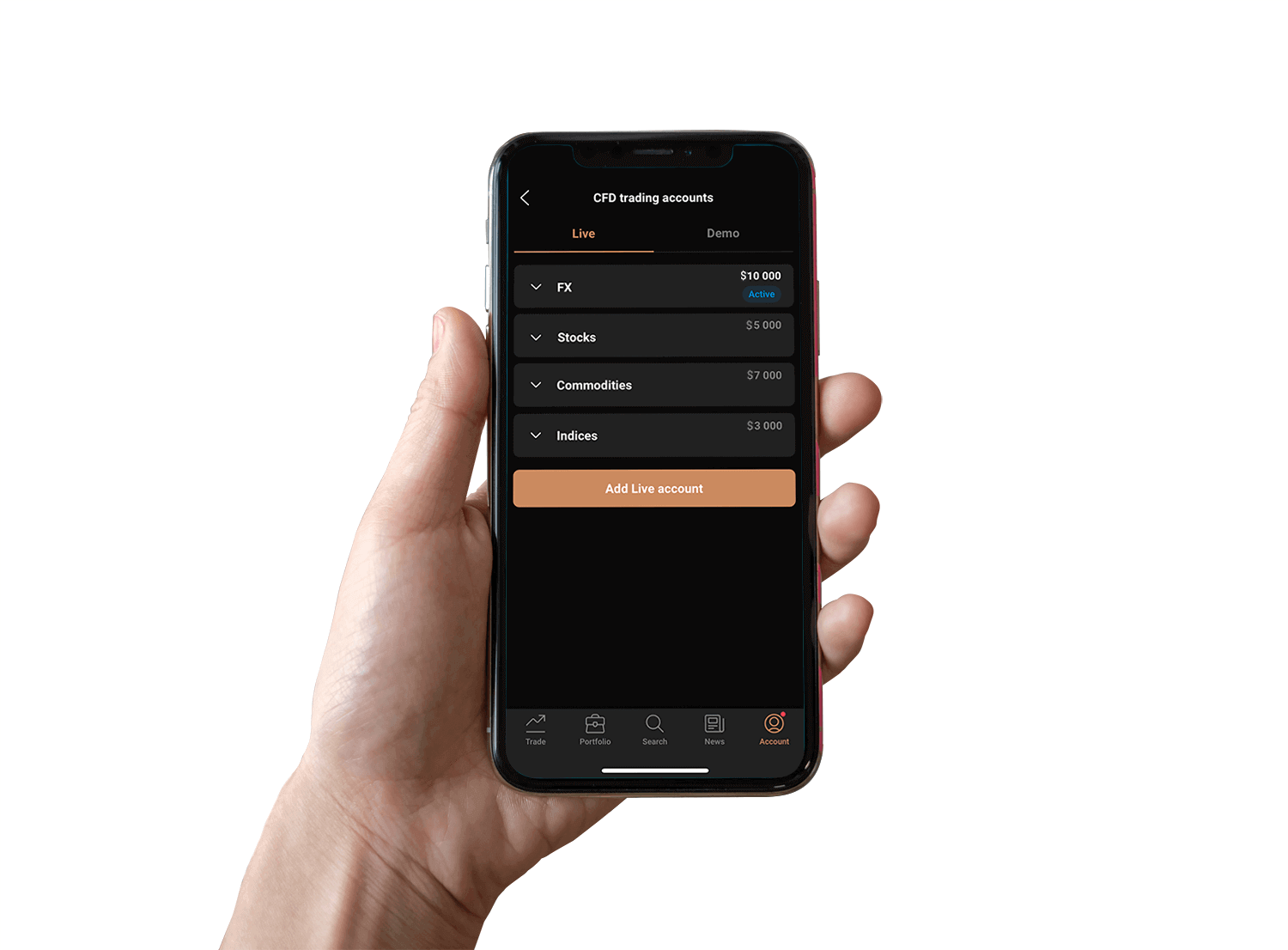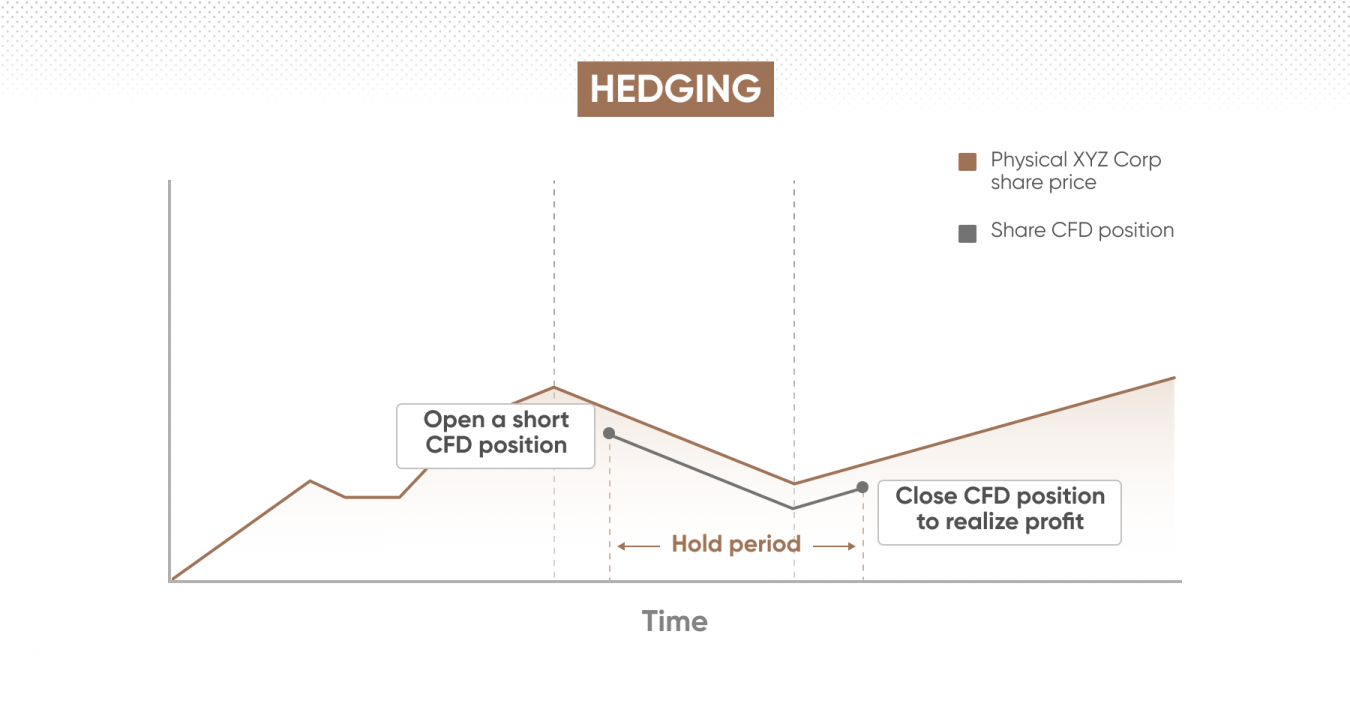What is CFD trading and how does it work?

CFD trading lets you speculate on the price movements of financial markets like shares, indices, commodities, and forex – without actually owning the asset. This guide covers what CFD trading is, how it works, and key risks to be aware of.
What is a contract for difference (CFD)?
A contract for difference (CFD) is a type of derivative product, meaning that it derives its price from an underlying asset. When you open a CFD with Capital.com, you agree with us to exchange the difference in the asset’s price between when you enter and exit the trade.
You can trade CFDs on 5,000+ markets on our platform, including:
Since CFDs are derivatives, you never take ownership of the actual asset. Instead, you’re simply speculating on whether the price will go up or down.
How does CFD trading work?
When you trade CFDs, you choose to go long (buy) if you think the market will rise, or go short (sell) if you think the market will fall.
Every trade shows two prices: the buy price and the sell price.
- If you want to go long (buy), you enter the trade at the buy price.
- If you want to go short (sell), you enter at the sell price.
You close a long position at the sell price, and close a short position at the buy price. The difference between the buy and sell prices is called the spread, which is the main cost your trade will incur.
Your profit or loss moves in line with the market price. If the market moves in your favour, you’ll profit – but if it moves against you, you’ll make a loss.
CFD positions are commonly opened and closed within short timeframes – often within one day – but you can hold them longer. However, holding overnight incurs additional fees.
What is a CFD account?
A CFD account can be opened with a broker to start trading CFDs. It gives you access to a trading platform where you can monitor the markets, place trades, view charts, and manage your account.
Some brokers may provide a demo account, which lets you practise trading with virtual funds before risking any real money. This is a good way to get familiar with the platform and understand how CFD trading works.
In many regions, you’ll need to pass an appropriateness check before opening a live account. This may involve answering a few questions to show you understand the risks of leveraged trading. It’s important to know how margin works and be aware of how quickly losses can occur.

What is leverage in CFD trading?
CFDs are typically traded on margin, which means you only need to deposit a portion of the total trade value to open a position. This is known as leveraged trading.
Leverage amplifies both profits and losses. For example, with a 20% margin (5:1 leverage) you only need $200 to open a $1,000 trade. But remember, gains and losses are calculated on the full $1,000, not just your deposit.
Example
You want to open a long CFD position on a stock priced at $100, and you buy 10 CFDs. The total position size is $1,000. With a 20% margin, you only need to deposit $200 at first.
That said, it’s important to keep more on your account than just enough for one trade. We’ll see why in a moment.
If the price rises
- If the price goes up to $110, your profit = $10 x 10 = $100.
- If it rises to $120, your profit = $20 x 10 = $200 – you've doubled your deposit.
If the price falls
- If the price drops to $99, your loss = $1 x 10 = $10.
However, if you only had $200 on your account, you now have less than 100% margin. You’ll receive a margin call asking you to deposit more margin, or risk being closed out.
If the price falls to $90, your loss = $10 x 10 = $100.
At this point, your position might be closed automatically.
Why? Well, when your account equity falls below 50% of your margin requirements (as it has here, since your margin requirement was $200), we begin to automatically close positions to prevent further loss.
This is why it's vital to manage your risk, and have enough money on your account to cover your margin requirements. Even small moves in the market can result in significant losses when leverage is involved.
Types of margin
Deposit margin is the initial amount you need to open a position. It’s calculated based on your trade size and the margin rate set by the regulator.
Maintenance margin is the minimum amount of equity you must keep in your account to keep trades open. If your balance falls below this level, you’ll receive a margin call.
CFD margin requirements can vary depending on the asset class and market conditions. Make sure you understand the specific margin levels before placing a trade.
What does CFD trading cost?
There are a few key costs to be aware of when you trade CFDs.
- Spread: this is the difference between the buy (ask) and sell (bid) price. You buy at the higher price and sell at the lower. The market needs to move in your favour by more than the spread to make a profit.
- Overnight funding adjustments: if you hold your position overnight, you’ll typically be charged a fee. This covers the cost of keeping your trade open with borrowed funds (margin).
- Guaranteed stop-loss fees (optional): if you set a guaranteed stop to close your position at your chosen level and limit further potential losses, you’ll be charged a fee when it triggers.
This isn’t an exhaustive list – different providers may charge for different services.
Capital.com does not charge commission on trades, deposits or withdrawals. However, other providers may have different fee structures. Always check before opening an account.
What assets can you trade with CFDs?

CFDs provide access to thousands of markets, including:
- Global shares like Apple, Tesla, and HSBC.
- Stock indices such as the US 500 or UK 100.
- Commodities like gold, oil, and silver.
- Major and minor forex pairs: EUR/USD, USD/JPY, and more.
- Cryptocurrencies including bitcoin and ether.
This broad range is one of the main reasons traders choose CFDs – they make it easy to diversify your portfolio from a single account. However, it’s important to remember that a wider choice of markets also means more opportunities for risk, so always trade carefully and manage your exposure.
Example CFD trade
Let’s compare opening a long CFD trade on a stock vs traditional investing. Values shown are for example purposes only.
| CFD trade | Share trade | |
|---|---|---|
| Deal | Buy at 135.10 | Buy at 135.10 |
| Deal size | 100 shares | 100 shares |
| Leverage | 5:1 | 0 |
| Cost to open | $2,702 ($135.10 x 100 / 5) | $13,510 (100 x $135.10) |
Scenario one: Profit
Suppose the price rises by 10 points and you decide to close your trade.
| CFD trade | Share trade | |
|---|---|---|
| Sell price | 145.05 | 145.05 |
| Deal | Sell at 145.05 | Sell at 145.05 |
| Profit | $995 (($145.05 - $135.10) x 100) | $995 ($14,505 - $13,510) |
Your profit is the same in monetary terms – but your return on capital is significantly higher with the CFD trade because you only needed to post 20% margin (using 5:1 leverage).
However, while leverage can amplify potential returns – it also increases the risk of losses.
Scenario two: Loss
Now, imagine the price drops 10 points and you close your position to limit your loss.
| CFD trade | Share trade | |
|---|---|---|
| Sell / price | 125.05 | 125.05 |
| Deal | Sell at 125.05 | Sell at 125.05 |
| Loss | $1,005 (($135.10 - $125.05) x 100) | $1,005 ($13,510 - $12,505) |
Again, your loss is the same in monetary terms, but it’s roughly a 37% loss on your CFD trade, compared to just 7% on the share trade.
Scenario three: You lose more than you deposited
Say the stock falls by 30 points.
| CFD trade | Share trade | |
|---|---|---|
| Sell price | 105.05 | 105.05 |
| Deal | Sell at 105.05 | Sell at 105.05 |
| Loss | $3,005 (($135.10 - $105.05) x 100) | $3,005 ($13,510 - $10,505) |
In this case, your CFD loss exceeds your initial deposit by over 100%, but your loss on the share trade is around 20%.
It’s likely your provider would have closed your position before reaching this point. Many regulators require CFD brokers to provide negative balance protection, ensuring your account balance never drops below zero.
However, your individual positions can still impact your account balance if markets move against you – highlighting the importance of risk management when trading CFDs.
CFD risk management tools
When trading CFDs, you have several tools available to help manage risk:
Stop-losses
A stop-loss automatically closes your trade if the market moves against you, at a price you specify. While this helps limit potential losses, stop-loss orders aren’t guaranteed – during volatile market conditions, your position might be closed at a worse price than expected (known as slippage).
Guaranteed stop-losses
You can protect your position even further with a guaranteed stop-loss order (GSLO). It works like a regular stop-loss but guarantees your trade will close at precisely the price you set, regardless of market volatility. Although you pay a small premium if your GSLO is triggered, you’re protected against slippage.
Trailing stops
A trailing stop is a dynamic stop-loss that moves with the market when it’s going in your favour, helping to lock in potential gains. If the market reverses direction, your trailing stop stays fixed, closing your position to limit losses. However, trailing stops aren’t guaranteed, so they can also be subject to slippage.
Take-profits
A take-profit automatically closes your trade at a favourable price you set, securing profits once your target is reached. It can help you lock in gains and avoid emotional trading decisions in CFD markets.
Learn more about risk management in trading.
Margin call and negative balance protection
Your CFD provider also has processes to help protect you – but you shouldn’t rely on these alone.
Margin calls and gradual close-out
If your equity (the value of your account) drops below 100% of your required maintenance margin, you may receive a margin call. This is a warning asking you to top up your balance or reduce your exposure. If you don’t act, your provider may close your positions to reduce risk.
At Capital.com, you’ll get a second margin call when your equity reaches 75% of your margin requirements. When it reaches 50%, we automatically start to close positions automatically to prevent further losses.
That said, you shouldn’t rely on margin calls as a risk management tool. Always monitor your positions and margins closely.
Negative balance protection
Many regulators require CFD brokers to offer negative balance protection to retail traders (non-professionals). This means that your account balance can’t drop below zero.
However, negative balance protection doesn’t prevent you from losing more than your initial deposit on any single trade when using leverage.
Professional clients – sometimes referred to as wholesale clients – don’t receive negative balance protection, so their potential losses can exceed account balances.
Potential benefits and risks of CFD trading
CFDs offer flexibility and access to a wide range of financial markets, and provides potential trading opportunities – as well as risks. Understand these factors to inform your trading.
Trade rising and falling markets
CFDs allow you to trade in both directions. You can go long (buy) if you think the market will rise, or short (sell) if you expect it to fall. This flexibility enables you to capitalise on market movements in either direction. However, if your prediction is incorrect, you can incur substantial losses, especially when leveraged positions magnify market moves.
Leverage and margin
CFDs are traded on margin, meaning you only deposit a fraction of the total trade value (margin) to open a position. Leverage can amplify profits if the market moves in your favour but also significantly magnifies losses if the market moves against you. Even small price changes can quickly result in losing your entire deposit, especially in volatile markets.
CFD markets and diversification
CFDs provide access to a broad range of markets from one platform, including shares, indices, commodities, forex, and cryptocurrencies. This can help diversify your trading strategy across different sectors and geographies, reducing exposure to any single market. However, having access to numerous markets also requires careful monitoring, as different asset classes can react to unpredictable events and economic conditions.
Hedge your existing investments
CFDs can help you hedge risk in your existing investment portfolio. For example, if you hold shares but expect short-term declines, you could open a short CFD position to offset potential losses. If the market falls, gains from your CFD trade can help mitigate losses in your other investments. However, incorrect timing or market moves in the opposite direction could lead to additional losses, potentially worsening your overall position.

Market volatility and risk management
Market volatility can lead to unexpected price movements, or 'gaps', where prices suddenly jump without trading at intermediate levels. This can result in slippage, meaning your trades may execute at less favourable prices than planned, increasing your losses. Tools like guaranteed stop-loss orders can help protect against this, though they come with additional costs if activated.
Margin calls and close-outs
If your account equity falls below required margin levels due to market movements, you may receive a margin call, requiring you to deposit additional funds or risk your positions being closed automatically (margin close-out). Rapid market movements can trigger these close-outs without advance notice, causing unexpected losses.
Product understanding and preparedness
CFDs are complex products. If you don’t fully understand margin, leverage, and risk management, it's easy to make costly mistakes. Practise your trading strategies using virtual funds with a demo account before trading with real money.
Learn more about CFD trading with our free educational resources.
Intuitive platform
Get the trading tools you need, without navigating through reams of unwanted data.
Fair and transparent pricing
Clearly see all the spreads and fees we charge – no hidden surprises.
TradingView and MT4
Seamlessly connect our platform with elite third-party software.
Comprehensive education
Improve your trading knowledge with our free guides and courses.
Rapid withdrawals
99% of withdrawals are processed within one business day, according to our internal server data from 2024.